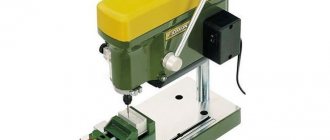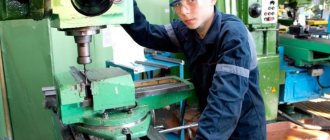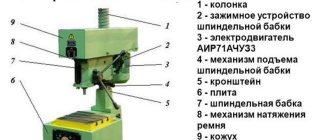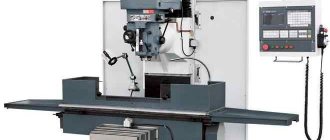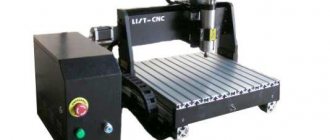The basic configuration of any equipment includes a set of mandatory functions, but often this is not enough to perform some operations. Additional equipment expands the possibilities. One type of such device is a rotary table for a milling machine. It is fixed to the base of the main structure and allows you to process complex shaped parts. Depending on the purpose, the size and brand of the rotary table is selected. It is important to consider equipment compatibility. Although in most cases such problems do not arise, since industry standards are as unified as possible and make it easy to use third-party products.
Rotary table device
Regardless of the class and complexity of the product, the principle of operation is the same for all. The basic elements of the device include:
- Base. Analogous to a machine bed. A system of attachment to the machine is required.
- Faceplate. Rotating part of the device. There is a hole in the center of the part (straight, but more often a Morse taper). There are T-shaped grooves on the working plane for fixing the workpiece or clamping mechanism. Modern models may use an original part fastening system. After installing the workpiece, the faceplate must be securely fixed in the desired position.
- Control. The faceplate can rotate around the central axis using a mechanical handle or an electric motor. CNC machines and specially designed rotary tables in modern design are programmable.
Select rotating tables
| Illustrations | Types of furniture and their descriptions |
| Classic rotating tables . In this design, the rotating tabletop is mounted on a vertical support. Thanks to the presence of a bearing, the rotating part of the furniture rotates 360 degrees around the support. | |
| Fine rotating tables . Such devices are used by professional photographers or video operators to shoot various objects from different angles. The photo shows a small homemade table with a small diameter rotating surface. | |
| Glass rotating podiums . Such designs are used to display jewelry and other small items that need to be shown favorably from different angles. | |
| Wooden rotating podiums . These are massive round dining tables, in the center of which there is a rotating structure made in the shape of a tray. The design is used during banquets and other events where it is customary to serve dishes beautifully. The presence of a rotating part is designed to facilitate access to dishes from anywhere on the table. | |
| Kinetic rotating podiums . The design is based on two combined transparent surfaces, onto which certain ornaments are applied. When the position of the transparent surfaces changes, the ornaments overlap each other in different ways, creating certain patterns, thereby achieving a special visual effect, as shown in the photo. | |
| Automotive podiums . Essentially, these are the same tabletops mounted on a movable support. The podium surface is driven by an electric motor with a reduction gearbox. Taking into account the weight of the exhibits, the structure of the turntable is assembled from rolled metal and made as durable as possible. |
Which of the listed designs should you choose for self-assembly? If the furniture is made for domestic use, we give preference to a conventional wooden structure, where a rotating tray is installed in the center of the round dining table.
Select a table top design with a rotating center
Assembly drawing with dimensions
The drawing shows a classic wooden table on a vertical support. A tray on a bearing is installed in the center of the tabletop. The dimensions indicated in the drawing are selected taking into account the comfortable placement of four people. In the assembly instructions we will be guided by these dimensions.
Diagram of a rotating unit based on a ball bearing
The drawing shows a rotating unit where the tray rotates thanks to a ball bearing. Such a unit, on the one hand, ensures smooth rotation of the tray, and on the other hand, guarantees a long service life of the entire structure. However, the design of the unit can be simplified without compromising the smoothness of rotation by removing the ball bearing.
Do it yourself: what to collect
Table setting with a rotating circle in the center
Let's say you have an ordinary, unremarkable round wooden table, but you want more comfortable dining furniture with a rotating center part for comfortable access to dishes. I offer simple instructions for assembling and installing that very rotating part, by turning which it will be easy to get this or that dish from any place at the table.
This is exactly the table you can make by following the suggested instructions.
The assembly instructions in this article are intended for round tables with a diameter of 1-1.2 m. What to do if there is no such furniture initially?
The instructions in the article are a guide to assembling a small tabletop. Therefore, simply increase the proposed dimensions and, in addition to the rotating part, assemble the main tabletop from the same boards.
Select materials
The most important thing you need is boards and screws for attaching them.
For work we use the following:
- Board 70×25 mm.
- Wood screws 30×5.
- Carpenter's glue.
- Paint and varnish materials for finishing works.
- Rolling bearing (alternatively, you can make it yourself, as described in the instructions).
Select tools
Using this tool, wooden pieces can be cut, drilled and joined with self-tapping screws
For work we use the following:
- Jigsaw.
- Screwdriver with bits and drills.
- Big compass.
- Clamps.
- Pencil and ruler.
- Painting tool.
Assemble a rotating table with your own hands
| Illustrations | Making and installing a turntable - step-by-step instructions |
Make a template. On old wallpaper or on unnecessary cardboard, draw a circle with a diameter of 550 mm. Cut out the circle according to the markings made earlier.
| |
| Mark the template into segments . Fold the paper circle in half and then three more times to get 8 identical wedges. | |
| Make an insert template . We measure 3 cm from the extreme point of the circle along the fold line. We connect the marked points and get the workpiece as in the photo. | |
| Cut out the inserts according to the template. We cut off one of the eight outer fragments from the template, as shown in the photo. We attach the template to the board and trace along the contour. We cut out the part according to the markings made. To make a curved cut we use a jigsaw. As a result, we make 8 identical blanks. | |
| Sand the liners . We smooth out the unevenness with sandpaper and clean the workpieces from dust. | |
| Make the base of the circle. We fold the previously prepared 8 parts and glue them end to end. In order to obtain acceptable gluing quality, we place the parts on a flat surface. From plywood 4 mm thick we cut out a circle with a diameter of 530 mm. We glue the plywood circle on top of the hoop glued together from wooden fragments. After the glue has completely dried, turn the circle upside down and remove the glue deposits from under the boards. | |
| Fill in the base of the circle . We apply planks to the notch of the circle one by one and cut them so that they fit close to the side along the edge. We glue the planks prepared in this way into the recess and place them under the load while they dry. | |
| Cover with varnish . We coat the finished tray with varnish or other paints and varnishes that match the design of the table. | |
| Install the turntable . We attach the outer ring of the sliding bearing to the main table top. We attach the bearing part to the bottom of the tray. We insert the tray into the bearing on the tabletop, after applying lubricant. |
Explanation of the instructions: how to make a plain bearing? In order for the rotary tabletop to rotate freely without swaying, you need a bearing, which you can make yourself.
The diagram shows a simple assembly that allows you to rotate the upper plane relative to the lower plane
The diagram shows a simple plain bearing consisting of two rings - an outer and an inner ring or cylinder. Both structural elements are attached to the corresponding sides of the combined countertops.
The gap between the outer and inner rings should be no more than 1-2 mm to avoid play. One ring is attached to one tabletop, the other to the other.
An example of a homemade rotation unit before attaching it to the tabletop
Perhaps the assembled unit, when scrolling, will not be as convenient as a ball bearing, but given the rotation speed of the rotary tabletop, this is not so important.
Calculate the labor costs and cost of making a table with a rotating center with your own hands
What will cost less – buying a table with a turning center or making such furniture yourself? Of course, it’s cheaper to do everything yourself. Let's try to calculate how much it will cost to make a rotating tabletop, described in the instructions.
You will need a board 70×25 mm, length 4 m, which costs on average 130 rubles. Plus, you need 20 self-tapping screws, which will cost 20 rubles. In total, the materials will cost 150 rubles, and to this we will add some wood glue and varnish and stain from a home workshop.
As for labor costs, they are quite comparable to assembling a regular dining table. If you only make a rotating tabletop for an already finished table, everything will take no more than one free day.
Operating principle of the equipment
The main task of the rotary table is to process parts in ways that are impossible on a conventional milling or lathe. The device allows you to realize the advantages of the above equipment. Parts in the form of a body of revolution are made on a lathe. It is impossible to leave unprocessed a part of the workpiece that extends beyond the cutting perimeter, but there is such a need. On a milling machine, a stationary part is processed using coordinate vectors. By installing a rotary table, you can make unfinished rotation bodies and bore holes that cannot be installed in a lathe.
The video shows how an automatic rotary table works for a 5-axis CNC machine.
This result is achieved by the fact that the workpiece is fixed not on the frame of the milling machine, but in a device that allows the workpiece to have an axis of rotation. This became the basic principle of operation of the turntable. Programmable equipment allows you to produce complex-shaped parts not on expensive machining centers, but using a regular milling machine, but with this wonderful device.
pros
A rotary table for a milling machine eliminates the need for changeovers to produce a single part. Labor costs and equipment downtime costs are reduced. No additional clamping equipment is required.
The accuracy of the contours and parts of the part is not inferior to the conventional processing method. In order to save money, you can purchase a used rotary table for a milling machine. But you will need specialists who can coordinate the movements of the axes.
Ready-made solutions eliminate the need for modifications. Equipment that has a rotary table for a milling machine can be immediately put into production. Modern software shells make the process of creating codes intuitive and easy to understand, even for those who have never dealt with complex electronics.
Equipment classification
It is customary to divide rotary tables according to several parameters. Firstly, in terms of working position. The equipment can be horizontal, vertical and universal, that is, it can work in two planes.
Secondly, in terms of size. The size of the faceplate is taken into account. It can vary from ∅ 110 mm to ∅ 630 mm. Tables of other sizes are possible, but these are special products made to order or for specific operations.
Thirdly, according to the method of adjustment and configuration. The equipment can be equipped with a simple mechanical handle, driven by the main machine and equipped with its own electric motor.
And finally, fourthly, a rotary table with expanded functionality. For example, it may have not one axis of rotation, but two, vertical and horizontal.
Constructive
You can make a rotary table for a milling machine with your own hands, but it will be difficult in this case, when the highest positioning accuracy is needed. After all, this can only be achieved if you use a servo motor. Accordingly, it will be necessary to configure the drive electronics and add software improvements. To do this, you will need at least a specialist adjuster for CNC systems.
The rotary table of a milling machine has the following main parts:
- The faceplate is where the workpiece is located. Made from high-alloy steels, strong for heavy loads and resistant to temperature changes, inactive to coolants.
- The previously loaded angular contact bearing bears the main load during rotation during processing.
- Worm pair - the accuracy of rotation depends on this unit. In the production process, diagnostics is used (the process of establishing a diagnosis, that is, a conclusion about the nature of the disease and the patient’s condition)
at a dental measuring center. - Brake discs prevent the axles from turning. Made from alloy steel.
Performance characteristics
The variety of models from different manufacturers opens up wide possibilities for choosing a specific product to achieve clearly defined goals. The specifics of the enterprise determine the characteristics of the installed rotary table. For exclusive high-precision work, models from proven companies of the highest accuracy class are chosen. The tolerances for such equipment are minimal and are:
- Rotation angle - 1 sec;
- Straightness of the working surface - 3.0 microns;
- Faceplate end runout - 1.5 microns;
However, such rotary tables are not cheap and in practice there is no need to use them in normal production. Most devices in this category are offered at more affordable prices, but with quite acceptable characteristics:
- Rotation angle - 1 min;
- Straightness of the working surface - 10-20 microns;
- Faceplate end runout - 12-20 microns;
The central hole, as a rule, is made in the form of a Morse cone No. 3 or No. 4. A universal way to effectively center the workpiece. Morse tapers are used in a similar way in almost all metalworking machines.
What kind of work is a rotary table used for?
The scope of application in metalworking is extremely wide.
Manufacturing of complex parts, such as flanges with fasteners, elements of mechanism housings. Effectively machining holes in parts that cannot be properly oriented in the lathe chuck. Workpieces with certain angular distances. Milling of grooves, ledges. Drilling holes at the same distance from the center of the part with a precisely specified angle relative to each other. It is very reasonable to use tooling for small- and medium-scale production. CNC machines and programmable rotary tables do much the same work as jig boring machines and machining centers.
Limitations in processing can only be caused by the size of the workpiece. The departure relative to the fixation point is regulated by the norms and rules of operation. The larger the part, the larger the diameter of the turntable faceplate should be. Exceeding the recommended values is unacceptable.
Capabilities
Lively systems have two axes of rotation:
- one can move 360 degrees relative to the center in the axis of rotation of the tool, most often this is the Z coordinate;
- 120 degrees - movement along the axis of swing of the structure.
To hold the part, a collet clamp can be used: manual or pneumatic. Vacuum systems that operate on the suction cup principle are also used. The advantage of the latter is the ease of changing the workpiece without clamping devices.
The rotation speed can reach 1000 revolutions per minute, which can significantly speed up the processing of parts. To protect moving parts, a bakelite panel is used. If the tool makes unexpected contact, the automatic cycle will stop.
Installing equipment on the machine
There should be no difficulties when fixing it to the base plate of the milling machine. The freely movable mounting bolts in the T-slots are brought into the mating holes or slots and the nuts are tightened. The operation is simple, but the considerable weight of the device requires caution during transportation. Place the turntable on a surface completely cleared of debris. The fit must be complete. The next stage of work will be setting up the equipment. The operation requires knowledge, experience and qualifications.
There are several ways to position the turntable correctly. Simple work where there is no need to maintain micron accuracy allows adjustment without special tools. A touch is made on a test workpiece with a cutter, then the table is rotated 180° and the operation of the cutting tool is repeated at a similar value. Tolerances and deviations are measured and adjusted by the required amount. It is much more difficult to configure equipment for high-precision work. Only qualified craftsmen can do it efficiently using special tools. Stops and limit switches are installed. A test sample is tested and if the accuracy requirements are met, then work begins. The technical specifications indicate the number of required measurements. All critical details are checked. When releasing a batch of products, you can measure not each one, but through the recommended number of pieces.
MX series. Rotation mechanisms with additional support for large diameter wheels
The mechanism is fixed on a support platform (round or square):
The large support area allows you to install a tabletop circle with a diameter of up to 140 cm on the mechanism.
The future rotating circle is attached to the ring mechanism with self-tapping screws. Before installing the rotating circle, it is necessary to remove the mechanism from the support platform. Attach the mechanism to the rotating circle. Then screw the platform back to the mechanism in its original place.
If necessary, the support platform is additionally attached to the table surface, for example, with self-tapping screws from below (through the table).
If you need advice on where to buy a circle tabletop, write to us. Tabletops are offered by various suppliers in Russia; round tabletops are available in a variety of decors and colors.
The load on the MX mechanism is up to 50 kg.
Recommendations for installation of MX mechanisms
Prices for MX rotation mechanisms:
Mechanism | Price, rub | Production time | Order |
| MX-50. Mechanism with a round support made of 16mm chipboard with a diameter of 50cm. We recommend for installation of a rotating tabletop with a diameter of 70-80 cm. Height 2.8 cm. Product weight 3.5 kg. | Top view | Bottom view | 3600 | January |
There is a solution for assembling large-diameter turntables: the Turn Kit (rotation mechanism with additional support rollers)
How to order. Payment. Delivery. Guarantee
Need some advice? We will answer your questions:
Advantages and disadvantages
Unsatisfactory performance of the equipment may be due to the wrong choice of model, or insufficient qualifications of the employee. The characteristics are clearly stated in the accompanying documents and, as a rule, guaranteed by the manufacturer. Individual cases of manufacturing defects are resolved on an individual basis.
The turntable has plenty of advantages. Having such equipment in your arsenal, you can master additional types of work or launch the production of new products. Some operations can be optimized. One of the applications of the rotary table is the processing of complex welded structures. They are often processed by hand. It takes a lot of time, and the quality leaves much to be desired. By setting up a milling machine with a rotary table for such an operation, the geometric dimensions of the parts become an order of magnitude more accurate, and the processing time is reduced many times over.
The payback of equipment depends on production volumes and can vary within significant limits, but there is no doubt that the enterprise will benefit in the quality of manufactured products.
Versatility
Inclined structures can be installed on traditional systems. For this purpose, the design included the installation of a single-axis GSA+ controller. Electronics are connected via conventional interfaces. Control is implemented by means of M-code transmission.
No matter what traditional three-axis machine can simply be converted into a five-axis system. Small configurations are made to the system, positioning sensors are often added, and the type of clamping device is selected:
- Manual drive.
- Pneumatic.
- Hydraulic.
The inclined pallet can also be used for routine processing operations. When necessary, control is activated through CNC commands and continues to work further. It is convenient to produce complex products on five-axis systems: helical grooves, fan blades, which are widely used in radial milling.

